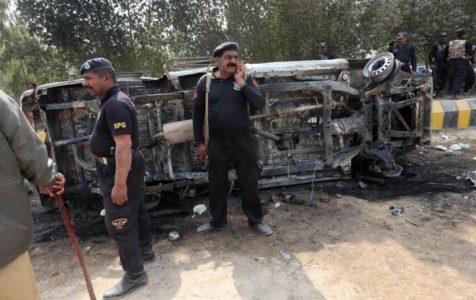
Islamic State’s Wilayah Khorasan bombs convoy carrying Pakistani politician
Yesterday, a suicide bomber dispatched by the Islamic State’s Wilayah Khorasan (Khorasan province) attacked a vehicle carrying Maulana Abdul Ghafoor Haideri, the deputy chairman of Pakistan’s Senate. Haideri, who is a senior figure in the Jamiatul-Ulema-e-Islam-Fazl (JUI-F), was wounded and subsequently hospitalized.
Dozens of others were killed or injured in the blast, which occurred in Mastung, a town in the Baluchistan province.
The bombing was quickly claimed online by the Islamic State’s Amaq News Agency and then in a separate statement from the group. Wilayah Khorasan also released a photo of its “martyr,” identifying him by the alias “Abu Nandalah al-Khurasani.”
“By the grace of Allah, istishhadi [“martyr”] brother Abu Nandalah al-Khurasani (may Allah accept him) was able to detonate his explosive vest on the convoy of the murtadd [“apostate”] Abdul Ghafoor Haideri, the vice president of the taghut Pakistani Congress near Quetta City in Pakistan,” the Islamic State’s statement reads. The bombing “resulted in his injury, the killing of more than 30 murtaddin of the police, intelligence personnel and bodyguards, and the injury of more than 40 others, and all praise is due to Allah.”
The JUI-F organized an online campaign to show support for Haideri. Prominent figures, such as former Pakistani president Pervez Musharraf, have condemned the bombing. JUI-F also created an image in Haideri’s honor that supporters are using online. The image, which can be seen above, includes rough English text that reads: “LongLive Haidri.”
JUI-F is led by Fazl ur-Rehman, a member of Pakistan’s assembly and the leader of the opposition. Both he and the JUI-F have been longtime supporters of the Taliban. He is widely credited with helping to create and sustain the Afghan Taliban by training many of its members in JUI-F madrassas located in the Baluchistan province and northwestern Pakistan.
JUI-F is an ideal target for Wilayah Khorasan as it both supports the Taliban, the Islamic State’s main rival in the region, and participates in Pakistan’s government. Years before the Islamic State planted its flag in Pakistan, jihadists targeted JUI-F leader Rehman in suicide attacks.
The bombing demonstrates that while Wilayah Khorasan has suffered significant losses, especially in neighboring Afghanistan, the group is still capable of carrying out lethal operations.
Wilayah Khorasan was built by former Afghan and Pakistani Taliban commanders who defected from their organizations to swear allegiance to Abu Bakr al Baghdadi’s self-declared caliphate. This local talent provides Baghdadi’s loyalists with an indigenous network that is difficult to uproot.
Mastung is not far from Quetta, the capital of Baluchistan province, which is a hub for numerous jihadist groups. Wilayah Khorasan has carried out other operations in Quetta and elsewhere in Baluchistan over the past year. However, some of these attacks have been claimed by other jihadists, making it difficult to discern who was responsible.
For example, both the Islamic State and Tehrik-i-Taliban Pakistan Jamaat-ur-Ahrar claimed responsibility for a suicide attack at a hospital in Quetta last August. Scores were killed or wounded in that bombing, which targeted lawyers who had gathered to mourn the head of the Baluchistan Bar Association.
The Pakistani Taliban and the Islamic State both claimed an Oct. 2016 suicide assault on a police academy in Quetta that killed at least 60 people and wounded more than 100. Pakistani officials claim still another jihadist group, Lashkar-e-Jhangvi al Alami, carried out the assault.
In addition to Pakistani officials and civilians, the Islamic State has also repeatedly targeted its jihadist rivals in the Afghan Taliban, some of whom operate in Pakistan. In mid-April, for instance, Wilayah Khorasan claimed the assassination of a prominent Taliban member in Peshawar.
For more background on the Islamic State’s Wilayah Khorasan, see FDD’s Long War Journal report: 2 American service members killed fighting Islamic State in eastern Afghanistan.
Source: Long War Journal





